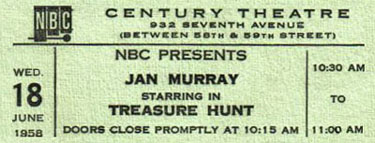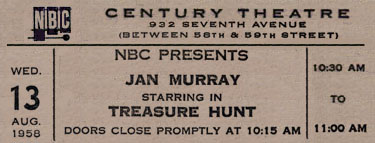Treasure Hunt (1956-1959)


Treasure Hunt started in 1956 as a weekly prime-time game show on ABC where it lasted all of one year. But NBC liked the program and they especially liked its host, comedian Jan Murray. They snatched it up for a five-a-week daytime slot from ’57 to ’59 and also gave it another brief try in prime time in 1958.
There were three “acts” to a game of Treasure Hunt, the first being the interview segment where Jan would chat with the contestants at some length, a la Groucho Marx and You Bet Your Life. The second part was a quiz with the contestants competing against one another for the right to go on a treasure hunt. The winner could select one of thirty treasure chests on the stage, guarded by the show’s “Pirate Girl” — a lovely model in an abbreviated Jolly Roger outfit. For much of the show’s run, the Pirate Girl was starlet Greta Thyssen, fresh from a series of supporting roles in Three Stooges comedies.
Then came the final part of the show — The Tease and Reveal. The chest could contain a huge amount of money, a trip around the world, a fur coat or some other fabulous prize…or it could contain a cheap booby prize. Murray would peek inside the chest, find out (without telling the contestant) what they’d won…and then try to convince them that it was something crummy and they should swap the contents for some modest amount of cash he was offering. I remember him dragging this out for long minutes with great theatrics and every so often, he’d succeed. Against the audience’s shouted advice, the contestant would take $300 instead of what was in the chest…which would turn out to be a new car. My aunt used to watch Murray making the “winners” sweat and squirm and she’d say, “Why do they have to do that to people? Why can’t they just let them win what they win?”
As you can see from the above tickets, the show was done from the Century Theatre in New York. The Century opened in 1921 as Jolson’s 59th Street Theatre (even though it faced Seventh Avenue) and Al Jolson starred in the first production on its stage, a musical called Bombo. It became a movie house called the Central Park Theatre in 1931, then went back to live productions as the Shakespeare Theatre the following year. In 1934, it was renamed the Venice Theater and then in ’42, it went back to being Jolson’s 59th Street Theatre (even though it still was not on 59th Street) for a year before being renamed The Molly Picon Theater. That name lasted four months…or until the show starring Molly Picon closed. Then it was back to the Jolson name for a few months while it showed movies…then in 1944, it again returned to live performances as The New Century Theater. It housed plays and musicals, including High Button Shoes and Kiss Me Kate, until 1954 when NBC bought it for television use. It was finally demolished in 1962.
Treasure Hunt moved into Rockefeller Center by the summer of 1959. I know this because that was when my mother and I went to New York for a trip that included being in the audience for a broadcast of a game show. We wanted to see Treasure Hunt, which was done in the adjoining studio, but it was sold out so we got in line for our second choice, Concentration. As we stood there, Jan Murray came by in a loud, checked sport coat and bantered with all of us who were waiting. I remember that even though I’d met TV stars by then, he absolutely terrified me and at age seven, I was too shy to respond when he stuck out his hand and tried to shake mine. But I also thought it was amazingly cool that he could walk out there, get everyone laughing and generate so much excitement among the tourists.
When NBC cancelled Treasure Hunt, it was with the idea of finding a better show for Murray to host. They signed him to a long-term contract and he was soon back with a game show called The Jan Murray Show, subtitled Charge Account. Much later, Treasure Hunt was revived in a syndicated version hosted by Geoff Edwards that ran from 1973 to 1977, then returned for another year in 1981. The Edwards version dispensed with everything in the old format except for the Tease and Reveal, which they made considerably more sadistic.






